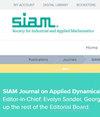加权伯克霍夫平均数和参数化方法
IF 1.8
4区 数学
Q2 MATHEMATICS, APPLIED
引用次数: 0
摘要
SIAM 应用动力系统期刊》,第 23 卷第 3 期,第 1766-1804 页,2024 年 9 月。 摘要。本研究提供了一种系统的方法,用于计算面积保留映射中准周期不变圆(以及此类圆的系统)的精确高阶傅里叶展开。该方法只需要从准周期圆中采样的有限数据集。我们的方法基于[A. Haro and R. de la LL]的参数化方法。Haro and R. de la Llave, SIAM J. Appl.Syst., 6 (2007), pp.Dyn.Syst.B, 6 (2006), pp. 1261-1300; A. Haro and R. de la Llave, J. Differential Equations, 228 (2006), pp.正确表述共轭方程的关键步骤是确定准周期子系统的旋转数。为此,我们利用了加权伯克霍夫平均法 [S. Das et al.S. Das 等人,《非线性》,30 (2017),第 4111-4140 页;S. Das 等人,《混沌基础重温》,Springer, Cham, 2016, 第 103-118 页;S. Das 和 J. A. Yorke,《非线性》,31 (2018),第 491-501 页]。除了上述轨道数据,这种方法还能准确计算旋转数。加权伯克霍夫平均数还有助于计算其他积分观测值,如不变圆参数化的傅里叶系数。由于参数化方法以牛顿方案为基础,我们只需对少量傅里叶系数进行低精度近似(例如几位正确数字),就能找到足够好的初始近似值,从而使牛顿收敛。此外,傅立叶系数可以独立计算,因此我们可以对高阶模式进行采样,从而猜测傅立叶系数的衰减率。这样,我们就可以先验地选择适当数量的截断模式。我们将举例说明这种方法对包括面积保持的赫农图谱和标准图谱(分别为多项式和三角非线性)在内的显式系统的实用性。我们举例说明了不变圆和多达 120 个分量的不变圆系统的计算。我们还采用数值延续方案(其中旋转数是延续参数)来计算这些系统中的大量准周期圆。在延续过程中,我们按照 [R. Calleja and R. de la Llave, Nonlinearity, 23 (2010), pp.本文章由计算机程序翻译,如有差异,请以英文原文为准。
Weighted Birkhoff Averages and the Parameterization Method
SIAM Journal on Applied Dynamical Systems, Volume 23, Issue 3, Page 1766-1804, September 2024.
Abstract. This work provides a systematic recipe for computing accurate high order Fourier expansions of quasiperiodic invariant circles (and systems of such circles) in area preserving maps. The recipe requires only a finite data set sampled from the quasiperiodic circle. Our approach, being based on the parameterization method of [A. Haro and R. de la Llave, SIAM J. Appl. Dyn. Syst., 6 (2007), pp. 142–207; A. Haro and R. de la Llave, Discrete Contin. Dyn. Syst. Ser. B, 6 (2006), pp. 1261–1300; A. Haro and R. de la Llave, J. Differential Equations, 228 (2006), pp. 530–579], uses a Newton scheme to iteratively solve a conjugacy equation describing the invariant circle (or systems of circles). A critical step in properly formulating the conjugacy equation is to determine the rotation number of the quasiperiodic subsystem. For this we exploit the weighted Birkhoff averaging method of [S. Das et al., Nonlinearity, 30 (2017), pp. 4111–4140; S. Das et al., The Foundations of Chaos Revisited, Springer, Cham, 2016, pp. 103–118; S. Das and J. A. Yorke, Nonlinearity, 31 (2018), pp. 491–501]. This approach facilities accurate computation of the rotation number given nothing but the already mentioned orbit data. The weighted Birkhoff averages also facilitate the computation of other integral observables like Fourier coefficients of the parameterization of the invariant circle. Since, the parameterization method is based on a Newton scheme, we only need to approximate a small number of Fourier coefficients with low accuracy (say, a few correct digits) to find a good enough initial approximation so that Newton converges. Moreover, the Fourier coefficients may be computed independently, so we can sample the higher modes to guess the decay rate of the Fourier coefficients. This allows us to choose, a priori, an appropriate number of modes in the truncation. We illustrate the utility of the approach for explicit example systems including the area preserving Hénon map and the standard map (polynomial and trigonometric nonlinearity respectively). We present example computations for invariant circles and for systems of invariant circles with as many as 120 components. We also employ a numerical continuation scheme (where the rotation number is the continuation parameter) to compute large numbers of quasiperiodic circles in these systems. During the continuation we monitor the Sobolev norm of the parameterization, as explained in [R. Calleja and R. de la Llave, Nonlinearity, 23 (2010), pp. 2029–2058], to automatically detect the breakdown of the family.
Abstract. This work provides a systematic recipe for computing accurate high order Fourier expansions of quasiperiodic invariant circles (and systems of such circles) in area preserving maps. The recipe requires only a finite data set sampled from the quasiperiodic circle. Our approach, being based on the parameterization method of [A. Haro and R. de la Llave, SIAM J. Appl. Dyn. Syst., 6 (2007), pp. 142–207; A. Haro and R. de la Llave, Discrete Contin. Dyn. Syst. Ser. B, 6 (2006), pp. 1261–1300; A. Haro and R. de la Llave, J. Differential Equations, 228 (2006), pp. 530–579], uses a Newton scheme to iteratively solve a conjugacy equation describing the invariant circle (or systems of circles). A critical step in properly formulating the conjugacy equation is to determine the rotation number of the quasiperiodic subsystem. For this we exploit the weighted Birkhoff averaging method of [S. Das et al., Nonlinearity, 30 (2017), pp. 4111–4140; S. Das et al., The Foundations of Chaos Revisited, Springer, Cham, 2016, pp. 103–118; S. Das and J. A. Yorke, Nonlinearity, 31 (2018), pp. 491–501]. This approach facilities accurate computation of the rotation number given nothing but the already mentioned orbit data. The weighted Birkhoff averages also facilitate the computation of other integral observables like Fourier coefficients of the parameterization of the invariant circle. Since, the parameterization method is based on a Newton scheme, we only need to approximate a small number of Fourier coefficients with low accuracy (say, a few correct digits) to find a good enough initial approximation so that Newton converges. Moreover, the Fourier coefficients may be computed independently, so we can sample the higher modes to guess the decay rate of the Fourier coefficients. This allows us to choose, a priori, an appropriate number of modes in the truncation. We illustrate the utility of the approach for explicit example systems including the area preserving Hénon map and the standard map (polynomial and trigonometric nonlinearity respectively). We present example computations for invariant circles and for systems of invariant circles with as many as 120 components. We also employ a numerical continuation scheme (where the rotation number is the continuation parameter) to compute large numbers of quasiperiodic circles in these systems. During the continuation we monitor the Sobolev norm of the parameterization, as explained in [R. Calleja and R. de la Llave, Nonlinearity, 23 (2010), pp. 2029–2058], to automatically detect the breakdown of the family.
求助全文
通过发布文献求助,成功后即可免费获取论文全文。
去求助
来源期刊

SIAM Journal on Applied Dynamical Systems
物理-物理:数学物理
CiteScore
3.60
自引率
4.80%
发文量
74
审稿时长
6 months
期刊介绍:
SIAM Journal on Applied Dynamical Systems (SIADS) publishes research articles on the mathematical analysis and modeling of dynamical systems and its application to the physical, engineering, life, and social sciences. SIADS is published in electronic format only.
 求助内容:
求助内容: 应助结果提醒方式:
应助结果提醒方式:


